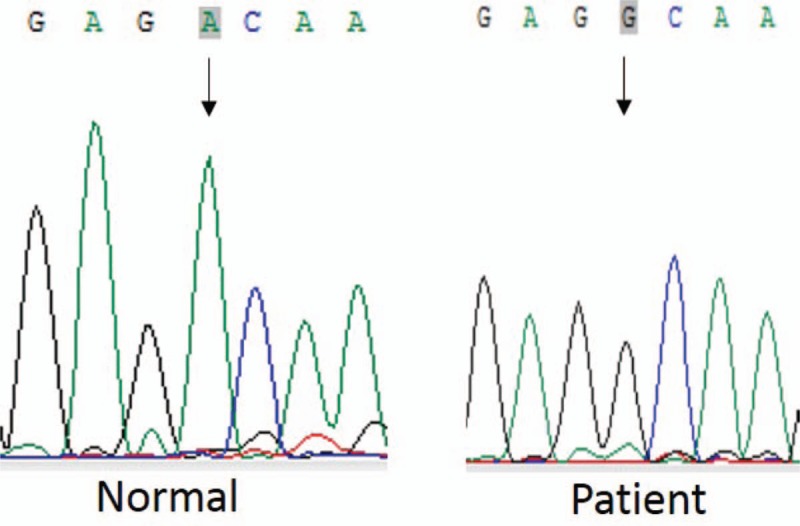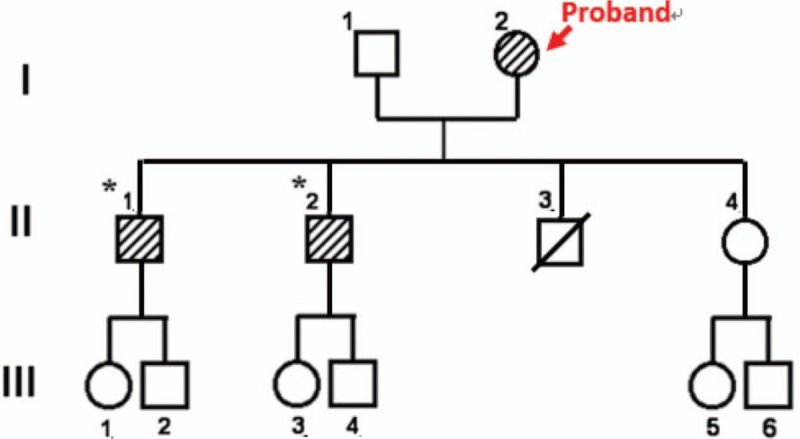Abstract
Rationale:
Mitochondrial DNA mutations have been associated with many maternal inherited diseases. A1555G mutation in mtDNA effects the gene code for rRNA, resulting in the structural change of human ribosome rending it susceptible to binding of the common antibiotic, aminoglycosides. Such mutation has linked with non-syndromic hearing loss and is one of the most common mtDNA mutations in Asian populations.
Patient concerns:
A 50-year-old Taiwanese female visited our neurology department with concern for multiple members with hearing loss in her family, including herself.
Diagnoses:
Physical examination findings were not significant besides hearing loss and brain MRI did not reveal any lesions. BAEP confirmed bilateral peripheral sensory deficit. Given the multiple cases of hearing loss in the family, a genetic cause was suspected. Using PCR and sequences chromatogram technique we have identified A1555G mutation on her mtDNA affecting region codes for 12S rRNA. Additionally, we observed severe speech disorder in two young family members with the onset of hearing loss began in their early childhood.
Interventions:
The patient declined any form of intervention at the time for personal reasons.
Outcomes:
The patient was satisfied with the diagnosis, her and her families are continuously followed by our neurology department.
Lessons:
We report on a family with mtDNA mutation hearing loss that is related to exposure to aminoglycosides. Children with such mutation are at high risk for impaired linguistic function. Early identification and intervention with cochlear implant should be considered.
Keywords: A1555G, aminoglycoside, hearing aid, hearing loss, mitochondrial DNA
1. Introduction
Mitochondrial DNA (mtDNA) contains 37 genes including 2 ribosomal RNAs, 22 transfer RNAs and numerous components of enzyme complexes involved in oxidative phosphorylation.[1] Point mutations in mtDNA results in modifications of tRNAs, rRNAs structure leading to deficiency in enzymes of electron transport chain and reduced mitochondria's ability to generate ATPs. Specifically, an adenine-to-guanine substitution at nt 1555 of the mtDNA (A1555G) is located on the gene that codes for 12S rRNA gene aminoacyl-tRNA acceptor site (A-site) and have been found to be associated with maternally inherited, nonsyndromic, aminoglycoside-related deafness.[2]
The structure of mutated 12S rRNA is similar to the bacterial Escherichia coli's 16S rRNA[3] (Fig. 1) and therefore is susceptible to the binding of aminoglycoside leading to interruption of RNA transcription and protein synthesis. Affected cells became vulnerable to oxidative stress and often lead to programmed cell death; apoptosis of the inner hair cells results in progressive sensorineural hearing loss.[2] The phenotypical presentation of A1555G mutation in a family varies widely; the age of onset is closely related to the time of aminoglycoside exposure, and the severity of hearing deficit seems to be affected by variable penetrance of the mutation.[4]
Figure 1.

Compares the amino acid sequnce of human 12S rRNAwild type to A1555G mutant 12S rRNA and Escherichia coli 16S rRNA. Mutant human 12S rRNA is structuraly similar to the bacterial 16S rRNA and therefore is supectible to antibiotic that acts on ribosome such as aminoglycosides.
In the presented family, 2 members with hearing loss also suffered from speech disorders. After reviewing the current literature, this association has not been clearly illustrated. We speculate the cause and the degree of speech impairment is related to the age of onset of hearing loss.
2. Case presentation
A 50-year-old Taiwanese woman with short stature came into clinic seeking for consultation regarding hearing loss in multiple family members including herself.
Her past medical history includes hypertension, osteoporosis, frequent cyclic headache, and progressive hearing loss started in her twenties. Patient has never used a hearing aid, her main form of communicates is by handwriting, and most of the information was provided by her daughter. She denied any significant past trauma or infection of the ear, however, 2 of her sons also has hearing impairment since the age of 3 and 4 respectively.
On physical examination, the patient was not able to the hear tuning fork at 256 and 512 Hz. Examination of tympanic membrane showed no abnormality of the middle ear. Weber and Rinne tests were not performed due to strong suspicion for genetic associated bilateral sensorineural hearing loss. Interestingly, patient reports that there has been a long family tradition to avoid Western medicine for an unknown reason; however, family members with normal hearing function are the ones that abide by Traditional Chinese medicine.
Further investigation included MRI of the brain and EEG with no significant findings in both tests. Brainstem auditory evoked potential (BAEP) however showed a poor waveform of all waves with stimulation in either ear that suggests bilateral peripheral lesions.
Given patient's extensive family history, inherited mitochondrial mutation was suspected as the etiology of her hearing loss. To search for mtDNA mutation A1555G, patient's deoxyribonucleic acid (DNA) was extracted and ran polymerase chain reaction (PCR) by MJ Research Thermal Cycler. The PCR products were digested with the restriction enzyme BsmAI (NEB) which can specifically recognize and cut the site. 10 μl were loaded onto 4% agarose gels and run through gel electrophoresis for 50 minutes at 100 V. The gels were stained with EtBr for 10 minutes after electrophoresis and viewed using ultraviolet light. To confirm the A to G mutation at nucleotide position 1555, the PCR product was analyzed using an ABI 3730 DNA Sequencer.
The patient was found to have A1555G mtDNA mutation (Fig. 2); upon further investigation, there are 2 family members who also suffer from hearing loss and the pedigree (Fig. 3) shows these individuals are associated with a maternally inherited pattern which is consistent with our speculation of mtDNA mutation.
Figure 2.

Mitochondrial DNA gene sequencing revealed A-to-G mutation at nt1555, this confirms patient's deafness is due to binding of aminoglycoside to mutated 12S rRNA product that subsequently cause inner hair cell apoptosis.
Figure 3.

This is the pedigree of patient presented in the case, showing 2 other family members also suffer from deafness. Proband is denoted as I-2 with diagnosed A1555G mutation. Individual II-1, II-2 (indicated with asterisk) became deaf at age of 3 and 4 respectively, and also suffered from impaired linguistic expression linked to loss of sensory stimulation during their language development stage.
3. Discussion
While the patient presented above did not have a clear history of being exposed to aminoglycoside, but her family history raised sufficient suspicion for the clinicians to run genetic testing. It is also worthwhile to notice that family members with hearing loss at a younger age, individuals II-1 and II-2 on the pedigree (Fig. 3), also suffers from impaired linguistic expression.
Among many types of deletion or point mutation of the mtDNA, A1555G is one of the most common mutations among Asian populations. This mutation is found in approximately 3% of the Japanese, 5.3% of Indonesian and 2.4% of the European patients with sensorineural hearing loss.[5] A screening done in China to identify hearing impaired children of school age found 813 cases of deaf students out of 504,348 students screened. Among them, aminoglycoside-related deafness accounted for 33.95%.[6] Another study, Chu et al.[7] examined 10 families with non-syndromic hearing impairment in Taiwan and reported 60% of family members had mtDNA mutation including A1555G and others.
Aminoglycoside has consistently been the third most commonly used antibiotic class in Taiwan trailing behind cephalosporin and penicillin.[8] Additionally, the habit of purchasing and selling of antibiotic from local pharmacies without proper prescription contributes to the incidence of aminoglycoside-related deafness. To completely avoid the use of aminoglycoside seems unfeasible and routine genetic testing is yet another issue to be discussed.[9] The focus here would be early recognition, diagnosis, and intervention of affected children to prevent language deficits.
Early auditory stimulation is the key in language development in children.[10] As mentioned above, individuals with deafness during childhood suffer from inability in linguistic expression specifically speech accuracy and the phonological aspect of language. Phonology is the bases of language; first, children must be able to identify the differences between each unit of sounds, then they can build the units into meaningful language. In children with sensorineural hearing loss, hearing aid offers both auditory input and help in shaping their linguistic expression. A retrospective cohort analysis in Canada showed that there is a significant improvement in expressive communication in hearing-impaired children after the fitting of hearing aid.[11] Another study evaluates the improvement in deaf children's expressive and receptive language skills post-hearing aid fitting showed an inverse correlation with age of diagnosis.[12] Meaning early diagnosis and fitting of hearing aid is associated with better outcome and higher language skills.
Bottom line is early recognition and diagnosis of hearing loss in patient with significant family history can prompt early hearing aid fitting and prevent further impairment in linguistic expression and language skill deterioration.
Author contributions
All authors contributed to writing the manuscript. All authors read and approved the final manuscript.
Conceptualization: Andy Wei-Ge Chen, Jun-Yang Fan.
Data curation: Andy Wei-Ge Chen, Ta-Tsung Lin.
Funding acquisition: Chin-San Liu.
Methodology: Wen-Ling Cheng.
Project administration: Mu-Kuan Chen.
Software: Wen-Ling Cheng.
Supervision: Chin-San Liu.
Validation: Andy Wei-Ge Chen, Ta-Tsung Lin, Mu-Kuan Chen.
Writing – original draft: Yang-Hao Ou.
Writing – review and editing: Jun-Yang Fan, Chin-San Liu.
Footnotes
Abbreviations: BAEP = brainstem auditory evoked potential, mtDNA = mitochondrial deoxyribonucleic acid, PCR = polymerase chain reaction, rRNA = ribosomal ribonucleic acid.
This research was supported by the Changhua Christian Hospital (104-CCH-ICO-007).
Written informed consent was obtained from the patient for publication of this case report and any accompanying images. This study has been approved by the Institutional Review Board on Humanities and Social Science Research, Changhua Christian Hospital IRB#110407.
The authors have no conflicts of interest to disclose.
References
- [1].Anderson S, Bankier AT, Barrell BG, et al. Sequence and organization of the human mitochondrial genome. Nature 1981;290:457–65. [DOI] [PubMed] [Google Scholar]
- [2].Estivill X, Govea N, Barceló E, et al. Familial progressive sensorineural deafness is mainly due to the mtDNA A1555G mutation and is enhanced by treatment of aminoglycosides. Am J Hum Genet 1998;62:27–35. [DOI] [PMC free article] [PubMed] [Google Scholar]
- [3].Böttger EC. Mutant A1555G mitochondrial 12S rRNA and aminoglycoside susceptibility. Antimicrob Agents Chemother 2010;54:3074–5. [DOI] [PMC free article] [PubMed] [Google Scholar]
- [4].Bae JW, Kim DB, Choi JY, et al. Molecular and clinical characterization of the variable phenotype in Korean families with hearing loss associated with the mitochondrial A1555G mutation. PLoS One 2012;7:e42463. [DOI] [PMC free article] [PubMed] [Google Scholar]
- [5].Malik SG, Pieter N, Sudoyo H, et al. Prevalence of the mitochondrial DNA A1555G mutation in sensorineural deafness patients in island Southeast Asia. J Hum Genet 2003;48:480–3. [DOI] [PubMed] [Google Scholar]
- [6].Fu S, Chen G, Dong J, et al. Prevalence and etiology of hearing loss in primary and middle school students in the hubei province of China. Audiol Neurotol 2010;15:394–8. [DOI] [PubMed] [Google Scholar]
- [7].Chu S, Chiang S, Chien Y, et al. Screening of mitochondrial DNA mutations in subjects with non-syndromic familial hearing impairment in Taiwan. Acta Paediatr Taiwan 2002;43:330–3. [PubMed] [Google Scholar]
- [8].Chang S, Chen Y, Hu O. Antibiotic use in public hospitals in Taiwan after the implementation of national health insurance. J Formos Med Assoc 2001;100:155–61. [PubMed] [Google Scholar]
- [9].Burton SK, Withrow K, Arnos KS, et al. A focus group study of consumer attitudes toward genetic testing and newborn screening for deafness. Genet Med 2006;8:779–83. [DOI] [PubMed] [Google Scholar]
- [10].Kuhl PK, Conboy BT, Coffey-Corina S, et al. Phonetic learning as a pathway to language: new data and native language magnet theory expanded (NLM-e). Philos Trans R Soc B Biol Sci 2008;363:979–1000. [DOI] [PMC free article] [PubMed] [Google Scholar]
- [11].Daub O, Bagatto MP, Johnson AM, Cardy JO. Language outcomes in children who are deaf and hard of hearing: the role of language ability before hearing aid intervention. J Speech Lang Hear Res 2017;60:3310–20. [DOI] [PubMed] [Google Scholar]
- [12].Kiese-Himmel C, Schroff J, Kruse E. Identification and diagnostic evaluation of hearing impairments in early childhood in German-speaking infants. Eur Arch Otorhinolaryngol 1997;254:133–9. [DOI] [PubMed] [Google Scholar]


